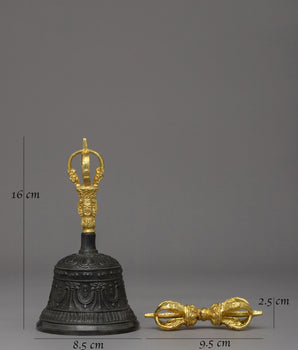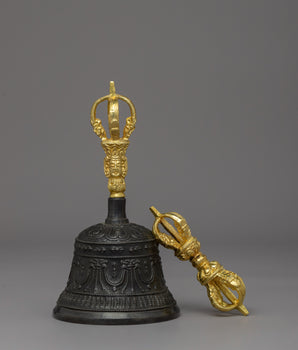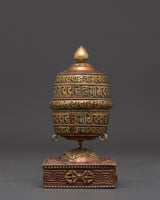
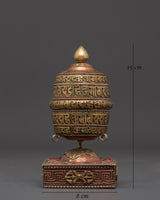
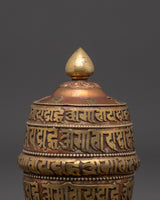
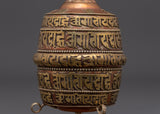
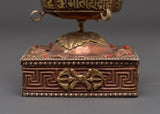
Handcrafted Prayer Wheel on Stand | Tibetan Sacred Religious Mantra Wheel

100% AUTHENTIC

HANDMADE

FREE SHIPPING
Handcrafted Tibetan Prayer Wheel on Stand | Spinning Tibetan Mantra Wheel Altar Decor
--------------------------------------------------------
Size: 15cm (Height) x 8cm (Width)
Weight: 0.25kg
Materials: Copper body, Brass body, Artificial Stone: Coral
--------------------------------------------------------
About our Prayer Wheel
This finely handcrafted Tibetan Prayer Wheel on stand measures 15cm in height, 8cm in width, and weighs 0.25kg. The wheel, made of polished copper and brass, is elaborately inscribed with the holy mantra "Om Mani Padme Hum" in repeated rows throughout its body. The spinning mechanism is smooth and functional, intended to improve spiritual focus during meditation.
The wheel's base features a Vajra pattern, representing the indestructible force of compassion and enlightenment. The pattern is enhanced by inlaid imitation red coral stones, which provide dynamic spiritual energy and visual beauty. The square stand is ornately decorated, giving the item balance and a sense of holy geometry, making it suitable for use on personal altars, desktops, or in prayer rooms.
This Tibetan Prayer Wheel is an ideal spiritual companion for daily practice or as a gift, offering a tangible connection to the profound wisdom of Buddhist traditions. It brings tranquility, merit, and attentiveness to your sacred area.
Introduction to Prayer Wheel
A prayer wheel is cylindrical on a spindle and is used in Tibetan Buddhism. It is typically inscribed with the mantra "Om Mani Padme Hum" and rotated by hand as a form of spiritual practice and to accumulate merit. Spinning the wheel is believed to have the same spiritual benefits as verbally reciting the mantra. The use of prayer wheels is widespread in Tibetan Buddhism and has spread to other cultures.
How does the Buddhist Prayer Wheel benefit us?
The benefits associated with rotating the wheel are numerous. It promotes knowledge, compassion, and bodhicitta in the practitioner and improves siddhis (spiritual powers such as clairvoyance, precognition, etc.). The practitioner can repeat the mantra as often as possible while the wheel is rolling, maintaining a calm, meditative attitude. A Tibetan Buddhist tradition holds that after a practice session, one should dedicate any acquired merits to the benefit of all sentient beings. Then three times Om Ah Hum. This is usually among Tibetans after finishing any Buddhist practice, including the prayer wheel exercise.
How do you set up your own Buddhist Shrine?
• Find a clean, quiet, and uncluttered spot
• Set up an altar table and cover it with an altar cloth that calls to you
• Place your sacred item at the center














